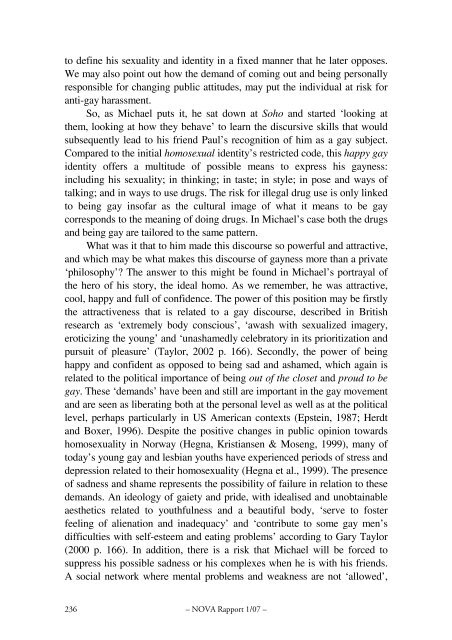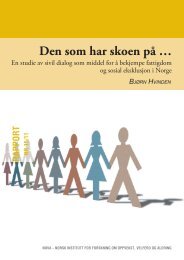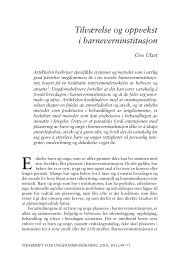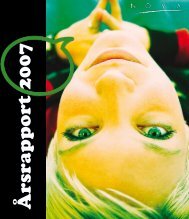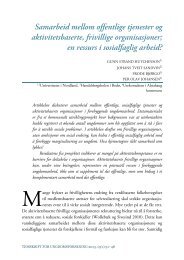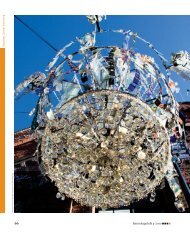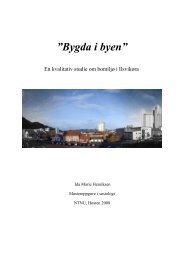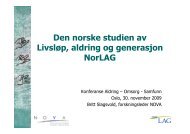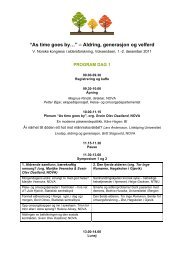Betydningen av seksuell erfaring, tiltrekning og identitet for ...
Betydningen av seksuell erfaring, tiltrekning og identitet for ...
Betydningen av seksuell erfaring, tiltrekning og identitet for ...
You also want an ePaper? Increase the reach of your titles
YUMPU automatically turns print PDFs into web optimized ePapers that Google loves.
to define his sexuality and identity in a fixed manner that he later opposes.<br />
We may also point out how the demand of coming out and being personally<br />
responsible <strong>for</strong> changing public attitudes, may put the individual at risk <strong>for</strong><br />
anti-gay harassment.<br />
So, as Michael puts it, he sat down at Soho and started ‘looking at<br />
them, looking at how they beh<strong>av</strong>e’ to learn the discursive skills that would<br />
subsequently lead to his friend Paul’s rec<strong>og</strong>nition of him as a gay subject.<br />
Compared to the initial homosexual identity’s restricted code, this happy gay<br />
identity offers a multitude of possible means to express his gayness:<br />
including his sexuality; in thinking; in taste; in style; in pose and ways of<br />
talking; and in ways to use drugs. The risk <strong>for</strong> illegal drug use is only linked<br />
to being gay insofar as the cultural image of what it means to be gay<br />
corresponds to the meaning of doing drugs. In Michael’s case both the drugs<br />
and being gay are tailored to the same pattern.<br />
What was it that to him made this discourse so powerful and attractive,<br />
and which may be what makes this discourse of gayness more than a private<br />
‘philosophy’? The answer to this might be found in Michael’s portrayal of<br />
the hero of his story, the ideal homo. As we remember, he was attractive,<br />
cool, happy and full of confidence. The power of this position may be firstly<br />
the attractiveness that is related to a gay discourse, described in British<br />
research as ‘extremely body conscious’, ‘awash with sexualized imagery,<br />
eroticizing the young’ and ‘unashamedly celebratory in its prioritization and<br />
pursuit of pleasure’ (Taylor, 2002 p. 166). Secondly, the power of being<br />
happy and confident as opposed to being sad and ashamed, which again is<br />
related to the political importance of being out of the closet and proud to be<br />
gay. These ‘demands’ h<strong>av</strong>e been and still are important in the gay movement<br />
and are seen as liberating both at the personal level as well as at the political<br />
level, perhaps particularly in US American contexts (Epstein, 1987; Herdt<br />
and Boxer, 1996). Despite the positive changes in public opinion towards<br />
homosexuality in Norway (Hegna, Kristiansen & Moseng, 1999), many of<br />
today’s young gay and lesbian youths h<strong>av</strong>e experienced periods of stress and<br />
depression related to their homosexuality (Hegna et al., 1999). The presence<br />
of sadness and shame represents the possibility of failure in relation to these<br />
demands. An ideol<strong>og</strong>y of gaiety and pride, with idealised and unobtainable<br />
aesthetics related to youthfulness and a beautiful body, ‘serve to foster<br />
feeling of alienation and inadequacy’ and ‘contribute to some gay men’s<br />
difficulties with self-esteem and eating problems’ according to Gary Taylor<br />
(2000 p. 166). In addition, there is a risk that Michael will be <strong>for</strong>ced to<br />
suppress his possible sadness or his complexes when he is with his friends.<br />
A social network where mental problems and weakness are not ‘allowed’,<br />
236<br />
– NOVA Rapport 1/07 –


